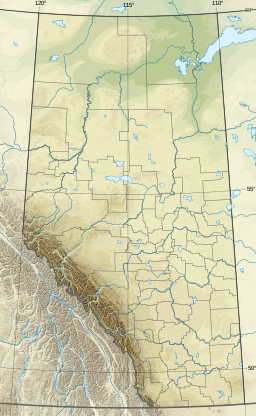| Lac Ste. Anne | |
|---|---|
| Location | Lac Ste. Anne County, Alberta |
| Coordinates | 53°42′30″N 114°27′37″W / 53.70833°N 114.46028°W |
| Type | eutrophic |
| Etymology | Saint Anne |
| Primary inflows | Sturgeon River |
| Primary outflows | Sturgeon River |
| Catchment area | 619 km2 (239 sq mi) |
| Basin countries | Canada |
| Surface area | 54.5 km2 (21.0 sq mi) |
| Average depth | 4.8 m (15.7 ft) |
| Max. depth | 9 m (30 ft) |
| Surface elevation | 730 m (2,400 ft) |
| Islands | Farming Island, Horse Island, Castle Island |
| Settlements | Alberta Beach, Sunset Point, Yellowstone, Ross Haven, West Cove, Lac Ste. Anne, Val Quentin |
| Official name | Lac Ste. Anne Pilgrimage National Historic Site of Canada |
| Designated | 2004 |
Lac Ste. Anne is a large lake in central Alberta, Canada. It is in Lac Ste. Anne County, along Highway 43, 75 km west of Edmonton.
The lake has a total area of 54.5 km2, a maximum depth of 9 m, and an average depth of 4.8 m.[1] Lac Ste. Anne lies at an elevation of 730 m, and has a drainage area of 619 km2. The eutrophic lake is formed along the Sturgeon River through which it drains into the North Saskatchewan River. Two islands are found at the western end of the lake, Farming Island and Horse Island, while the small Castle Island and tiny Rock Island lie at the eastern tip of the lake.
Along the southern area coal mines generate power and employment, and recreational businesses have flourished because of the lakes. Agriculture is still a mainstay and the area is known for some of the best oat crops in Canada.
- ^ Atlas of Alberta Lakes - Lac Ste. Anne
